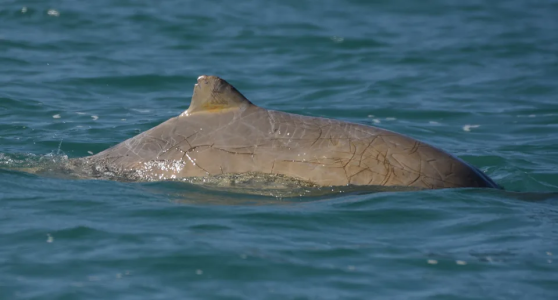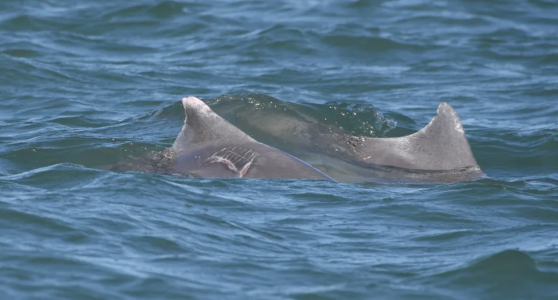Queensland dolphin photos reveal an unexpected secret
Our oceans hold an array of beautiful mysteries and creatures, and one of the most intelligent and enchanting is dolphins. These friendly and playful creatures are adored by many, including us here at Seniors Discount Club. So when we came across this fascinating news story about Queensland's dolphins, we had to share it with you.
Researchers behind an ongoing study at Flinders University have been analysing thousands of dolphin photos from south, central, and north Queensland. Shockingly, many of these images reveal that many of Australia's dolphins are scarred with severe lacerations and what appear to be bite marks. While some abrasions result from fights between dolphins or collisions with boats, others are caused by sharp teeth.

As it turns out, these dolphins are surviving attacks from bull, tiger, and white sharks in Queensland's coastal waters. Until now, little was known about the predation risk these two dolphin species faced or how often they managed to survive these fierce confrontations.
Caitlin Nicholls, a researcher from the university's Cetacean Ecology, Behaviour and Evolution Lab, described some bite marks the team discovered as 'pretty gnarly'.
According to Nicholls, 'They're semi-circle bite marks, and you can see the punctures from their teeth. There's often dragging from where the dolphin has wriggled away.' These bites would be lethal to a human.
Dolphins are blessed with fast-growing, thick skin, which enables them to recover from these attacks. The ongoing study aims to help researchers understand where dolphins are frequently being targeted and the types of injuries they endure. Furthermore, this data will establish a baseline for the scientists to track if predation pressure increases over time, potentially affecting the dolphin population.

Interestingly, the study revealed that the closer the dolphins were to the coast, the more likely they were to have visible scarring. Among the regions surveyed, dolphins inhabiting Townsville's waters experienced more bite marks as compared to those in Gladstone or Bowen.
Nicholls also noted that when researchers had access to images of the entire dolphin, they were more likely to discover evidence of scarring. A large number of these bites were located on the mid-flank, just below the dorsal fin, believed to be an area that allows for a higher chance of survival when bitten.
'If they get bitten in this area, we think they're more likely to survive the attack,' says Nicholls. 'Whereas if they get bitten, maybe on their head or tail, it's more likely to be a fatal attack because it would immobilise the dolphin, and they wouldn't be able to swim away.'
In recent years Australia has stepped up its efforts to conserve dolphins and their habitats. Across the country, various organisations are researching the species, raising awareness of the importance of dolphins, and advocating for better protection and management of their populations.
This includes the work of the Australian Marine Wildlife Research and Rescue Organisation (AMWRRO), attempting to better understand coastal dolphin populations in New South Wales, Victoria and South Australia. They’re also contributing to the efforts to keep Australia’s dolphins safe from human threats, such as by-catch in fishing nets and deliberate hunting.
Likewise, the World Wide Fund for Nature (WWF) seeks to raise awareness of the threats facing dolphins and reduce their harm from human activities. The organisation is working with fisheries in Queensland to protect dolphins in the Great Barrier Reef Marine Park, as well as developing a number of initiatives to reduce plastic pollution, which is a significant threat to marine species, including dolphins.
These organisations play a vital role in protecting dolphins, ensuring their future in Australia and beyond. We can all do our part to protect this unique marine mammal species by learning more about their behaviours, regulations and standards and supporting conservation groups and initiatives.
 To all our SDC members who have a deep affinity for the ocean and its captivating inhabitants, did this fascinating research on the resilience and tenacity of dolphins resonate with you? Does it further enhance your admiration for these incredible creatures? We hope that you found this discovery as enlightening as we did.
To all our SDC members who have a deep affinity for the ocean and its captivating inhabitants, did this fascinating research on the resilience and tenacity of dolphins resonate with you? Does it further enhance your admiration for these incredible creatures? We hope that you found this discovery as enlightening as we did.
Researchers behind an ongoing study at Flinders University have been analysing thousands of dolphin photos from south, central, and north Queensland. Shockingly, many of these images reveal that many of Australia's dolphins are scarred with severe lacerations and what appear to be bite marks. While some abrasions result from fights between dolphins or collisions with boats, others are caused by sharp teeth.

This particular snubfin dolphin was among several photographed displaying scars from shark attacks. Source: CEBEL/Flinders University.
As it turns out, these dolphins are surviving attacks from bull, tiger, and white sharks in Queensland's coastal waters. Until now, little was known about the predation risk these two dolphin species faced or how often they managed to survive these fierce confrontations.
Caitlin Nicholls, a researcher from the university's Cetacean Ecology, Behaviour and Evolution Lab, described some bite marks the team discovered as 'pretty gnarly'.
According to Nicholls, 'They're semi-circle bite marks, and you can see the punctures from their teeth. There's often dragging from where the dolphin has wriggled away.' These bites would be lethal to a human.
Dolphins are blessed with fast-growing, thick skin, which enables them to recover from these attacks. The ongoing study aims to help researchers understand where dolphins are frequently being targeted and the types of injuries they endure. Furthermore, this data will establish a baseline for the scientists to track if predation pressure increases over time, potentially affecting the dolphin population.

There are visible indications that a humpback dolphin has experienced a shark attack. Source: CEBEL/Flinders University
Interestingly, the study revealed that the closer the dolphins were to the coast, the more likely they were to have visible scarring. Among the regions surveyed, dolphins inhabiting Townsville's waters experienced more bite marks as compared to those in Gladstone or Bowen.
Nicholls also noted that when researchers had access to images of the entire dolphin, they were more likely to discover evidence of scarring. A large number of these bites were located on the mid-flank, just below the dorsal fin, believed to be an area that allows for a higher chance of survival when bitten.
'If they get bitten in this area, we think they're more likely to survive the attack,' says Nicholls. 'Whereas if they get bitten, maybe on their head or tail, it's more likely to be a fatal attack because it would immobilise the dolphin, and they wouldn't be able to swim away.'
Dolphin Conservation Efforts in Australia
In recent years Australia has stepped up its efforts to conserve dolphins and their habitats. Across the country, various organisations are researching the species, raising awareness of the importance of dolphins, and advocating for better protection and management of their populations.
This includes the work of the Australian Marine Wildlife Research and Rescue Organisation (AMWRRO), attempting to better understand coastal dolphin populations in New South Wales, Victoria and South Australia. They’re also contributing to the efforts to keep Australia’s dolphins safe from human threats, such as by-catch in fishing nets and deliberate hunting.
Likewise, the World Wide Fund for Nature (WWF) seeks to raise awareness of the threats facing dolphins and reduce their harm from human activities. The organisation is working with fisheries in Queensland to protect dolphins in the Great Barrier Reef Marine Park, as well as developing a number of initiatives to reduce plastic pollution, which is a significant threat to marine species, including dolphins.
These organisations play a vital role in protecting dolphins, ensuring their future in Australia and beyond. We can all do our part to protect this unique marine mammal species by learning more about their behaviours, regulations and standards and supporting conservation groups and initiatives.
Key Takeaways
- Researchers from Flinders University discovered high numbers of Australian dolphins with severe scarring, including evidence of bite marks.
- The study found that dolphins are surviving attacks from bull, tiger, and white sharks in coastal waters across south, central, and north Queensland.
- Dolphins have fast-growing, thick skin, allowing them to recover after attacks.
- Data from this ongoing study will help researchers understand where dolphins are frequently being attacked and what sort of injuries they are surviving, and allow them to understand if predation pressure increases.







